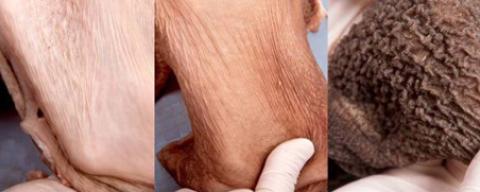The Key to Ruminal Development
Figure 1 (courtesy of Jud Heinrichs, Penn State University, used by permission from the author)
In the image on the left, the rumen of a calf fed milk only shows little papillae development. In the image in the middle, the rumen of a calf fed milk and hay shows little papillae development. In the image on the right, the rumen of a calf fed milk and grain shows significant papillae.
Why is starter grain important?
Ruminal development as a calf dictates long-term rumen health and function as an adult, lactating cow. Increased ruminal development as a calf results in better developed rumen papillae (“finger-like” projections that line the rumen and help to absorb nutrients) (Figure 1), which leads to better nutrient uptake. The more nutrients a calf can absorb, the more she can utilize said nutrients when it comes to growth and everyday metabolic functions.
When should I start offering grain, and how much should I give?
Grain can be offered within the first week of life, and it is very common for calves to receive a grain allowance starting on day one. Calves do not consume a large amount of grain at first, but it is important that their intake is never restricted.
To decrease waste, young calves should only be offered about one handful of grain at a time. Large amounts will go stale or begin to mold before the calf will be able to consume it all. Once grain is in poor condition, calves will not eat it; grain should always be kept fresh and in a palatable state. As calf appetite and feed intake increases, the amount of grain being offered should increase as well.
What type of grain should I feed my calves?
There are many different types of starter grains that range in texture, moisture, nutritional content, and cost. The two main categories of starter are textured and pelleted.
One of the most common factors that is taken into consideration when choosing a starter is the amount of crude protein (CP). The average starter has 16-24% CP, and the amount that a calf may need depends on various factors. For example, larger breeds (such as Holsteins) or calves that are fed a milk replacer that is lower in CP will have better growth and development rates if their starter is on the higher end for CP (Rosemond, 2023).
Textured Grain
Calves usually prefer textured starter grain (Cullens, 2018), which is a mixture of various grains and pellets. Molasses is a common binder in most textured starters, and it also helps to increase palatability.
Pelleted Grain
Pelleted grain allows calves to have more uniform uptake of nutrients, since every pellet is virtually the same. This also reduces sorting, as every piece is consistent in terms of size, texture, and moisture. Pelleted grain is potentially more digestible due to how it is processed (Litherland et al., 2014), and it will also attract less flies since there is no molasses coating.
Should I give my calves hay in addition to grain?
Feeding hay can help balance the rumen pH and keep the environment from becoming too acidic. Pelleted grain is more likely to cause rumen acidosis due to the “high levels of readily digestible starch” (Jones et al., 2022), so hay can be fed as a buffer to help maintain a healthy rumen pH.
Regardless of grain type, hay should be fed to every calf once they are consuming larger amounts of grain (~5-6 lbs/day or 7-8 weeks old) to help prevent acidosis (Jones et. al., 2022).
What about water?
Water should be offered on day one of life to all calves, and should never be restricted. The water that calves consume via milk goes to the abomasum, not the rumen. Plain water will go directly to the rumen and will aid in papillae development (Amaral-Phillips).
Clean, fresh water does not only aid in hydration, but also plays a key role in ruminal development, and should never be overlooked.
References
- Cullens, F. 2018. Starter for Pre-Weaned Calves. https://www.canr.msu.edu/news/starter_for_pre_weaned_calves.
- Jones, C.M., and J. Heinrichs. 2022. Feeding the Newborn Dairy Calf.
- Litherland, N.B., D.N.L. Da Silva, R.J. LaBerge, J. Schefers, and A. Kertz. 2014. Supplemental fat for dairy calves during mild cold stress. Journal of Dairy Science 97:2980–2989. doi:https://doi.org/10.3168/jds.2013-6942.
- Pennsylvania State University, and L. Martin. 2014. Comparison of Rumen Lining of Calves Fed: Milk, Milk + Hay, Milk + Grains. Kenpal Farm Products Inc.
- Rosemond, R. 2023. Review of Nutrient Requirements of Dairy Cattle: Requirements for Young Calves. https://extension.psu.edu/review-of-nutrient-requirements-of-dairy-cattle-requirements-for-young-calves.
Photo Credit
- Jud Heinrichs, Penn State University, used by permission from the author
Extension Services & Tools That Help NH Farmers Grow
Newsletters: Choose from our many newsletters for production agriculture
Receive Pest Text Alerts - Text UNHIPM to (866) 645-7010

